Revival of Charge Density Waves and Charge Density Fluctuations in Cuprate High-Temperature Superconductors
Abstract
1. Introduction
2. Results
2.1. General Properties
2.2. Phase Separation—Spin and Charge Order
- -
- Stripes with strong interplay between charge and spin degrees of freedom (Figure 2a) observed in the LSCO family by neutron scattering since 1995 [20]. Charge and spin incommensurate modulation vectors qc = 2π/λc and qs = 2π/λs are strictly related (qs = qc/2) one to another and align along the Cu-O bond.However, both spin and charge modulation were observed simultaneously in co-doped LSCO only (e.g., La1.48Nd0.4Sr0.12CuO4); otherwise, there was no detection of charge modulation (only spin).
- -
- Charge Density Wave (Figure 2b). Charge and spin degrees of freedom evolve independently one from another [21,22]. CDWs, foreseen since 1995 [17], were until 2011 elusive, contrasted, and confirmed only indirectly. Due to the improvement of resonant X-ray scattering (RXS), CDWs are now ubiquitously observed (see, e.g., [21,22,23,24,25,26,27,28]) in cuprate families, and most investigated among the orders competing with SC in countless papers following the pioneering paper on YBCO by Ghiringhelli et al. [23].
3. A Digression for Alex Müller and My Memories
4. Correlated Fermi Liquid and CDW Fluctuations
4.1. Correlated Fermi Liquid Instability Producing a Charge Density Wave State
4.2. Theoretical Realization
4.3. Correction to Mean Field Due to Fluctuations
- -
- In two dimensions (2D), the density of states N(ω) is constant and δm is ln-divergent. It is then impossible to satisfy the criticality condition of vanishing m(T) and there is no transition at finite T, as in general for a continuous symmetry. A quantum critical point and charge order are possible only at T = 0. In 2D and finite T, dynamical charge fluctuations (CDFs) only can be present.
- -
- The drastic role of fluctuations can be reduced by cutting their long-range effect in the loop integral with an infrared cut-off (possibly of the order of to simulate the quasi-2D structure of cuprates. Lowering T at fixed doping gives rise to a quasi-critical dynamical CDW (QC-CDW), which can be observed with sensitive experiments like RXS.
- -
- In three dimension (3D), N(ω) vanishes as ω goes to zero and makes δm finite also at finite T. By lowering T further, the QC-CDW may cross over to a long-range 3D-CDW, which is however hidden by superconductivity.
4.4. Experimental Observation of the Scenario Presented Above
4.5. Strange Metallic Behavior Above T*
5. Conclusions
Funding
Acknowledgments
Conflicts of Interest
References and Note
- The importance of A.K. Müller’s contribution in this field is stated e.g., by the quotations he received in the fundamental paper by Hohenberg, P.C.; Halperin, B. Theory of dynamic critical phenomena. Rev. Mod. Phys. 1977, 49, 435. [Google Scholar] [CrossRef]
- Thomas, H.; Müller, K.A. Theory of a Structural Phase Transition Induced by the Jahn-Teller Effect. Phys. Rev. Lett. 1972, 28, 800. [Google Scholar] [CrossRef]
- Bednorz, J.G.; Müller, K.A. Possible high-Tc superconductivity in the Ba-La-Cu-O system. Z. Phys. B 1986, 64, 189–193. [Google Scholar] [CrossRef]
- Anderson, P.W. The Resonating Valence Bond State in La2CuO4 and Superconductivity. Science 1987, 235, 119. [Google Scholar] [CrossRef] [PubMed]
- Caprara, S. The Ancient Romans’ Route to Charge Density Waves in Cuprates. Condens. Matter. 2019, 4, 60. [Google Scholar] [CrossRef]
- Arpaia, R.; Caprara, S.; Fumagalli, R.; De Vecch, G.; Peng, Y.Y.; Andersson, E.; Betto, D.; De Luca, G.M.; Brookes, N.P.; Lombardi, F.; et al. Dynamical charge density fluctuations pervading the phase diagram of a copper-based high Tc superconductor. Science 2019, 365, 906–9010. [Google Scholar] [CrossRef]
- Seibold, G.; Arpaia, R.; Peng, Y.Y.; Fumagalli, R.; Braicovich, L.; Di Castro, C.; Grilli, M.; Ghiringhelli, G.; Caprara, S. Marginal Fermi Liquid behaviour from charge density fluctuations in Cuprates. arXiv 2019, arXiv:1905.10232. (to be published in Commun. Phys.). [Google Scholar]
- Ando, Y.; Komiya, S.; Segawa, K.; Ono, S.; Kurita, Y. Electronic Phase Diagram of High-Tc Cuprate Superconductors from a Mapping of the In-Plane Resistivity Curvature. Phys. Rev. Lett. 2004, 93, 26700. [Google Scholar] [CrossRef]
- Timusk, T.; Statt, B. The pseudogap in high temperature superconductors: An experimental survey. Rep. Prog. Phys. 1999, 62, 61–122. [Google Scholar] [CrossRef]
- Rubio Temprano, D.; Mesot, J.; Janssen, S.; Conder, K.; Furrer, A.; Mutka, H.; Müller, K.A. Large Isotope Effect on the Pseudogap in the High-Temperature Superconductor HoBa2Cu4O8. Phys. Rev. Lett. 2000, 84, 1990–1993. [Google Scholar] [CrossRef] [PubMed]
- Emery, V.J.; Kivelson, S.A.; Lin, H.Q. Phase separation in the t-J model. Phys. Rev. Lett. 1990, 64, 475. [Google Scholar] [CrossRef] [PubMed]
- Cancrini, N.; Caprara, S.; Castellani, C.; Di Castro, C.; Grilli, M.; Raimondi, R. Phase separation and superconductivity in Kondo-like spin-hole coupled model. Europhys. Lett. 1991, 14, 597. [Google Scholar] [CrossRef]
- Grilli, M.; Raimondi, R.; Castellani, C.; Di Castro, C.; Kotliar, G. Phase separation and superconductivity in the U=infinite limit of the extended multiband Hubbard model. Int. J. Mod. Phys. B 1991, 5, 309. [Google Scholar] [CrossRef]
- Raimondi, R.; Castellani, C.; Grilli, M.; Bang, Y.; Kotliar, G. Charge collective modes and dynamic pairing in the three-band Hubbard model. II. Strong-coupling limit. Phys. Rev. B 1993, 47, 3331. [Google Scholar] [CrossRef] [PubMed]
- Löw, U.; Emery, V.J.; Fabricius, K.; Kivelson, S.A. Study of an Ising model with competing long- and short-range interactions. Phys. Rev. Lett. 1994, 72, 1918. [Google Scholar] [CrossRef]
- Emery, V.J.; Kivelson, S.A. Frustrated electronic phase separation and high-temperature superconductors. Phys. C Supercond. 1993, 209, 597–621. [Google Scholar] [CrossRef]
- Castellani, C.; Di Castro, C.; Grilli, M. Singular Quasiparticle Scattering in the Proximity of Charge Instabilities. Phys. Rev. Lett. 1995, 75, 4650. [Google Scholar] [CrossRef] [PubMed]
- Perali, A.; Castellani, C.; Di Castro, C.; Grilli, M. D-wave superconductivity near charge instabilities. Phys. Rev. B 1996, 54, 16216. [Google Scholar] [CrossRef]
- Monthoux, P.; Balatsky, A.V.; Pines, D. Weak-coupling theory of high-temperature superconductivity in the antiferromagnetically correlated copper oxides. Phys. Rev. B 1992, 46, 14803. [Google Scholar] [CrossRef]
- Tranquada, J.M.; Sternlieb, B.J.; Axe, J.D.; Nakzmura, Y.; Uchida, S. Evidence for stripe correlations of spins and holes in copper oxide superconductors. Nature 1995, 375, 561. [Google Scholar] [CrossRef]
- Blaco-Caosa, S.; Frano, A.; Schierle, E.; Porras, J.; Loew, T.; Minola, M.; Bluschke, M.; Weschke, E.; Keimer, B.; Le Tacon, M. Resonant X-ray scattering study of charge-density- wave correlations in YBa2Cu3O6+x. Phys. Rev. B 2014, 90, 54513. [Google Scholar] [CrossRef]
- Hücker, M.; Christensen, N.B.; Holmes, A.T.; Blackburn, E.; Forgan, E.M.; Liang, R.; Bonn, D.A.; Hardy, W.N.; Gutowski, O.; Zimmermann, M.V.; et al. Competing charge, spin, and superconducting orders in underdoped YBa2Cu3Oy. Phys. Rev. B 2014, 90, 54514. [Google Scholar] [CrossRef]
- Ghiringhelli, G.; Le Tacon, M.; Minola, M.; Blanco-Canosa, S.; Mazzoli, C.; Brookes, N.B.; De Luca, G.M.; Frano, A.; Hawthorn, D.G.; He, F.; et al. Long-range incommensurate charge fluctuations in(Y,Nd)Ba2Cu3O6+x. Science 2012, 337, 821. [Google Scholar] [CrossRef] [PubMed]
- Comin, R.; Damascelli, A. Resonant X-Ray Scattering Studies of Charge Order in Cuprates. Annu. Rev. Condens. Matter Phys. 2016, 7, 369–405. [Google Scholar] [CrossRef]
- Chang, J.; Blackburn, E.; Holmes, A.T.; Christensen, N.B.; Larsen, J.; Mesot, J.; Liang, R.; Bonn, D.A.; Hardy, W.N.; Watenphul, A.; et al. Direct observation of competition between superconductivity and charge density wave order in YBa2Cu3O6.67. Nat. Phys. 2012, 8, 871. [Google Scholar] [CrossRef]
- Achkar, A.J.; Hawthorn, D.; Sutarto, R.; Mao, X.; He, F.; Frano, A.; Blanco-Canosa, S.; le Tacon, M.; Ghiringhelli, G.; Braicovich, L.; et al. Distinct charge orders in the planes and chains of ortho-III-ordered YBa2Cu3O6+_ superconductors identified by resonant elastic x-ray scattering. Phys. Rev. Lett. 2012, 109, 167001. [Google Scholar] [CrossRef]
- Tabis, W.; Li, Y.; Le Tacon, M.; Braicovich, L.; Kreyssig, A.; Minola, M.; Dellea, G.; Weschke, E.; Veit, M.J.; Ramazanoglu, M.; et al. Charge order and its connection with Fermi-liquid charge transport in a pristine high-Tc cuprate. Nat. Commun. 2014, 5, 5875. [Google Scholar] [CrossRef] [PubMed]
- Comin, R.; Frano, A.; Yee, M.M.; Yoshida, Y.; Eisaki, H.; Schierle, E.; Weschke, E.; Sutarto, R.; He, F.; Soumyanarayanan, A.; et al. Charge order driven by Fermi-arc instability in Bi2Sr2−xLaxCuO6+δ. Science 2014, 343, 390. [Google Scholar] [CrossRef]
- Wu, T.; Mayaffre, H.; Krämer, S.; Horvatić, M.; Berthier, C.; Hardy, W.N.; Liang, R.; Bonn, D.A.; Julien, M.-H. Magnetic-field-induced charge-stripe order in the high-temperature superconductor YBa2Cu3Oy. Nature 2011, 477, 191. [Google Scholar] [CrossRef]
- Wu, T.; Mayaffre, H.; Krämer, S.; Horvati´c, M.; Berthier, C.; Kuhn, P.L.; Reyes, A.P.; Liang, R.; Hardy, W.N.; Bonn, D.A.; et al. Emergence of charge order from the vortex state of a high-temperature superconductor. Nat. Commun. 2013, 4, 2113. [Google Scholar] [CrossRef]
- Laliberté, F.; Frachet, F.; Benhabib, S.; Borgnic, B.; Loew, T.; Porras, J.; Le Tacon, M.; Keimer, B.; Wiedmann, S.; Proust, C.; et al. High field charge order across the phase diagram of YBa2Cu3Oy. NPJ Quantum Mater. 2018, 3, 11. [Google Scholar] [CrossRef]
- Doiron-Leyraud, N.; Proust, C.; LeBoeuf, D.; Levallois, J.; Bonnemaison, J.; Liang, R.; Bonn, D.A.; Hardy, W.N. Taillefer Louis Quantum oscillations and the Fermi surface in an underdoped high-Tc superconductor. Nature 2007, 447, 565–568. [Google Scholar] [CrossRef]
- Grissonnanche, G.; Cyr-Choinière, O.; Laliberté, T.; René de Cotret, S.; Juneau-Fecteau, A.; Dufour-Beauséjour, S.; Delage, M.È.; LeBoeuf, D.; Chang, J.; Ramshaw, B.J.; et al. Direct measurement of the upper critical field in cuprate superconductors. Nat. Commun. 2014, 5, 3280. [Google Scholar] [CrossRef] [PubMed]
- LeBoeuf, D.; Doiron-Leyraud, N.; Vignolle, B.; Sutherland, M.; Ramshaw, B.J.; Levallois, J.; Daou, R.; Laliberté, F.; Cyr-Choinière, Q.; Chang, J.; et al. Lifshitz critical point in the cuprate superconductor YBa2Cu3Oy from high-field Hall effect measurements. Phys. Rev. B 2011, 83, 54506. [Google Scholar] [CrossRef]
- Doiron-Leyraud, N.; Lepault, S.; Cyr-Choinière, O.; Vignolle, B.; Grissonnanche, G.; Laliberté, F.; Chang, J.; Barisic, N.; Chan, M.K.; Ji, L.; et al. Hall, Seebeck and Nernst coefficients of underdoped HgBa2CuO4+δ: Fermi-surface reconstruction in an archetypal cuprate superconductor. Phys. Rev. X 2013, 3, 21019. [Google Scholar]
- Chang, J.; Daou, R.; Proust, C.; Leboeuf, D.; Doiron-Leyraud, N.; Laliberté, F.; Pingault, B.; Ramshaw, B.J.; Liang, R.; Bonn, D.A.; et al. Nernst and Seebeck coefficients of the cuprate superconductor YBa2Cu3O6.67: A study of fermi surface reconstruction. Phys. Rev. Lett. 2010, 104, 57005. [Google Scholar] [CrossRef]
- Barišić, N.; Badoux, S.; Chan, M.K.; Dorow, C.; Tabis, W.; Vignolle, B.; Yu, G.; Béard, J.; Zhao, X.; Proust, C.; et al. Universal quantum oscillations in the underdoped cuprate superconductors. Nat. Phys. 2013, 9, 761. [Google Scholar] [CrossRef]
- Grissonnanche, G.; Legros, A.; Badoux, S.; Lefrançois, E.; Zatko, V.; Lizaire, M.; Laliberté, F.; Gourgout, A.; Zhou, J.-S.; Pyon, S.; et al. Giant thermal Hall conductivity in the pseudogap phase of cuprate superconductors. Nature 2019, 571. [Google Scholar] [CrossRef]
- Leboeuf, D.; Kramer, S.; Hardy, W.N.; Liang, R.; Bonn, D.A.; Proust, C. Thermodynamic phase diagram of static charge order in underdoped YBa2Cu3Oy. Nat. Phys. 2012, 9, 79–83. [Google Scholar] [CrossRef]
- Sachdev, S.; Ye, J. Universal quantum-critical dynamics of two-dimensional antiferromagnets. Phys. Rev. Lett. 1992, 69, 2411. [Google Scholar] [CrossRef]
- Sokol, A.; Pines, D. Toward a unified magnetic phase diagram of the cuprate superconductors. Phys. Rev. Lett. 1993, 71, 2813. [Google Scholar] [CrossRef] [PubMed]
- Monthoux, P.; Pines, D. Nearly antiferromagnetic Fermi-liquid description of magnetic scaling and spin-gap behavior. Phys. Rev. B 1994, 50, 16015. [Google Scholar] [CrossRef] [PubMed]
- Abanov, A.; Chubukov, A.; Schmalian, J. Quantum-critical theory of the spin-fermion model and its application to cuprates: Normal state analysis. Adv. Phys. 2003, 52, 119. [Google Scholar] [CrossRef]
- Castellani, C.; Di Castro, C.; Grilli, M. Possible occurrence of band interplay in high Tc superconductors. In Proceedings of the International Conference on High-Temperature Superconductors and Materials and Mechanisms of Superconductivity Part II, Interlaken, Switzerland, 28 February–4 March 1988; Physica C 153–155. pp. 1659–1660. [Google Scholar]
- Müller, K.A.; Benedeck, G. Phase Separation in Cuprate Superconductors. In Proceedings of the 3rd Workshop “The Science and Culture-Physics”, Erice, Italy, 6–12 May 1992; World Scientific: Singapore, 1993. [Google Scholar]
- Müller, K.A.; Sigmund, E. Phase Separation in Cuprate Superconductors. In Proceedings of the Second International Workshop on “Phase Separation in Cuprate Superconductors”, Cottbus, Germany, 4–10 September 1993; Springer: Verlag, Germany, 1994. [Google Scholar]
- Bianconi, A.; Saini, N.L.; Lanzara, A.; Missori, M.; Rossetti, T.; Oyanag, H.; Yamaguchi, H.; Oka, K.; Ito, T. Determination of the Local Lattice Distortions in the CuO2 plane of La1.85Sr0.15CuO4. Phys. Rev. Lett. 1996, 76, 3412. [Google Scholar] [CrossRef]
- Ramshaw, B.J.; Sebastian, S.E.; McDonald, R.D.; Day, J.; Tan, B.S.; Zhu, Z.; Betts, J.B.; Liang, R.; Bonn, D.A.; Hardy, W.N.; et al. Quasiparticle mass enhancement approaching optimal doping in a high-Tc superconductor. Science 2015, 348, 317–320. [Google Scholar] [CrossRef]
- Becca, F.; Tarquini, M.; Grilli, M.; Di Castro, C. Charge-density waves and superconductivity as an alternative to phase separation in the infinite-U Hubbard-Holstein model. Phys. Rev. B 1996, 54, 12443–12457. [Google Scholar] [CrossRef]
- Castellani, C.; Di Castro, C.; Grilli, M. Non-Fermi Liquid behavior and d-wave superconductivity near the charge density wave quantum critical point. Zeit. Phys. 1997, 103, 137–144. [Google Scholar] [CrossRef]
- Seibold, G.; Becca, F.; Bucci, F.; Castellani, C.; Di Castro, C.; Grilli, M. Spectral properties of incommensurate charge-density wave systems. Eur. Phys. J. B 2000, 13, 87. [Google Scholar] [CrossRef]
- Benfatto, L.; Caprara, S.; Di Castro, C. Gap and pseudogap evolution within the charge-ordering scenario for superconducting cuprates. Eur. Phys. J. B 2000, 17, 95. [Google Scholar] [CrossRef]
- Chakravarty, S.; Laughlin, R.B.; Morr Dirk, K.; Nayak, C. Hidden order in the cuprates. Phys. Rev. B 2001, 63, 94503. [Google Scholar] [CrossRef]
- Andergassen, S.; Caprara, S.; Di Castro, C.; Grilli, M. Anomalous Isotopic Effect Near the Charge-Ordering Quantum Criticality. Phys. Rev. Lett. 2001, 87, 5641. [Google Scholar] [CrossRef] [PubMed]
- Yu, B.; Tabis, W.; Bialo, I.; Yakhou, F.; Brookes, N.; Anderson, Z.; Tan, G.Y.; Yu, G.; Greven, M. Unusual dynamic charge-density-wave correlations in HgBa2CuO4+. arXiv 2019, arXiv:1907.10047. [Google Scholar]
- Miao, H.; Fabbris, G.; Nelson, C.S.; Acevedo-Esteves, R.; Li, Y.; Gu, G.D.; Yilmaz, T.; Kaznatcheev, K.; Vescovo, E.; Oda, M.; et al. Discovery of Charge Density Waves in cuprate Superconductors up to the Critical Doping and Beyond. arXiv 2020, arXiv:2001.10294. [Google Scholar]
- Lin, J.Q.; Miao, H.; Mazzone, D.G.; Gu, G.D.; Nag, A.; Walters, A.C.; Garcia-Fernandez, M.; Barbour, A.; Pelliciari, J.; Jarrige, I.; et al. Nature of the charge-density wave excitations in cuprates. arXiv 2020, arXiv:2001.10312. [Google Scholar]
- Miao, H.; Lorenzana, J.; Seibold, G.; Peng, Y.Y.; Amorese, A.; Yakhou-Harris, F.; Kummer, K.; Brookes, N.B.; Konik, R.M.; Thampy, V.; et al. High-temperature charge density wave correlations in La1:875Ba0:125CuO4 without spin-charge locking. Proc. Natl. Acad. Sci USA 2017, 114, 12430. [Google Scholar] [CrossRef] [PubMed]
- Miao, H.; Fumagalli, R.; Rossi, M.; Lorenzana, J.; Seibold, G.; Yakhou-Harris, F.; Kummer, K.; Brookes, N.B.; Gu, G.D.; Braicovich, L.; et al. Formation of incommensurate Charge Density Waves in Cuprates. Phys. Rev. 2019, 9, 031042. [Google Scholar] [CrossRef]
- Wang, Q.S.; Horio, M.; Von Arx, K.; Shen, Y.; Mukkattukavil, D.J.; Sassa, Y.; Ivashko, O.; Matt, C.E.; Pyon, S.; Takayama, T.; et al. High-Temperature Charge-Stripe Correlations in La1.675Eu0.2Sr0.125CuO4. Phys. Rev. Lett. 2020, 124, 187002. [Google Scholar] [CrossRef]
- Campi, G.; Bianconi, A.; Poccia, N.; Bianconi, G.; Barba, L.; Arrighetti, G.; Innocenti, D.; Karpinski, J.; Zhigadlo, N.D.; Kazakov, S.M.; et al. Inhomogeneity of charge-density-wave order and quenched disorder in a high-Tc superconductor. Nature 2015, 525, 359. [Google Scholar] [CrossRef]
- Varma, C.M.; Littlewood, P.B.; Schmitt-Rink, S.; Abrahams, E.; Ruckenstein, A.E. Phenomenology of the normal state of Cu-O high-temperature superconductors. Phys. Rev. Lett. 1989, 63, 1996. [Google Scholar] [CrossRef]
- Legros, A.; Benhabib, S.; Tabis, W.; Laliberté, F.; Dion, M.; Lizaire, M.; Vignolle, B.; Vignolles, D.; Raffy, H.; Li, Z.Z.; et al. Universal T-linear resistivity and Planckian dissipation in overdoped cuprates. Nat. Phys. 2019, 15, 142–147. [Google Scholar] [CrossRef]
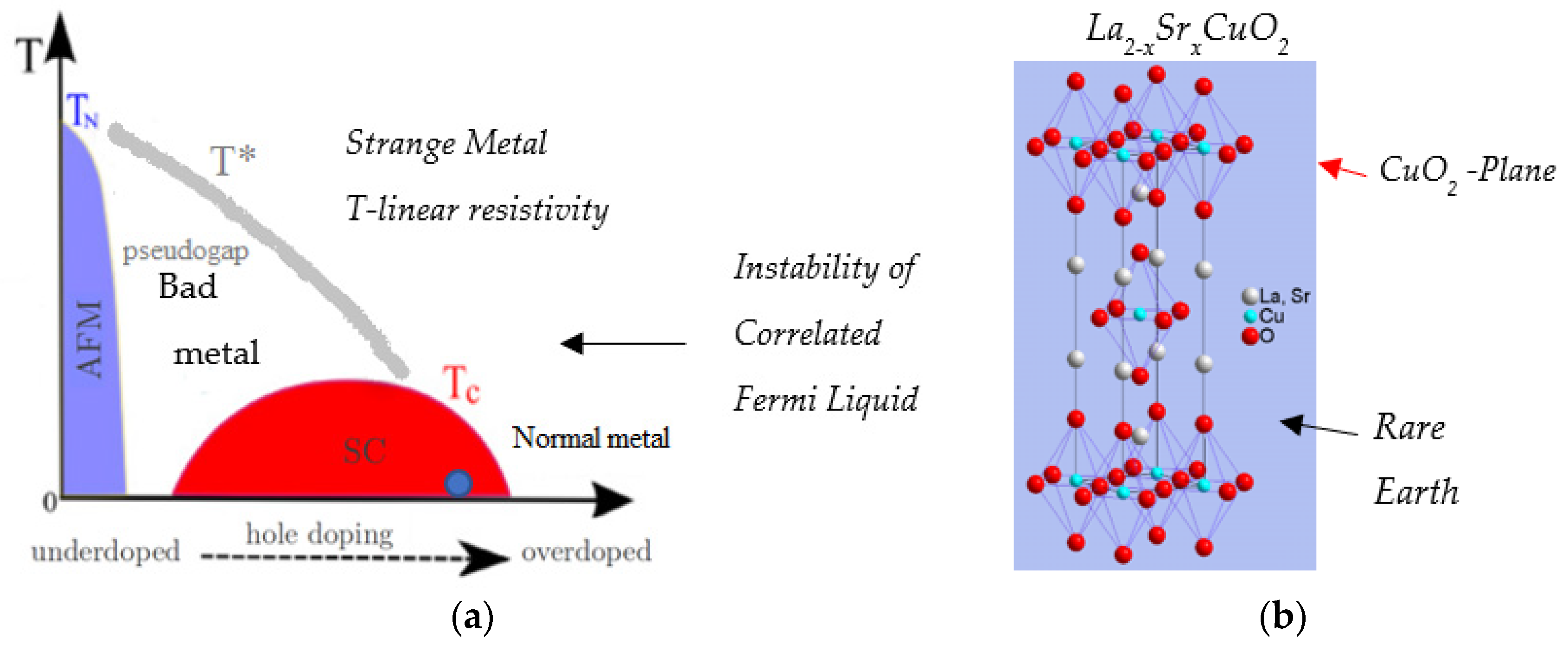
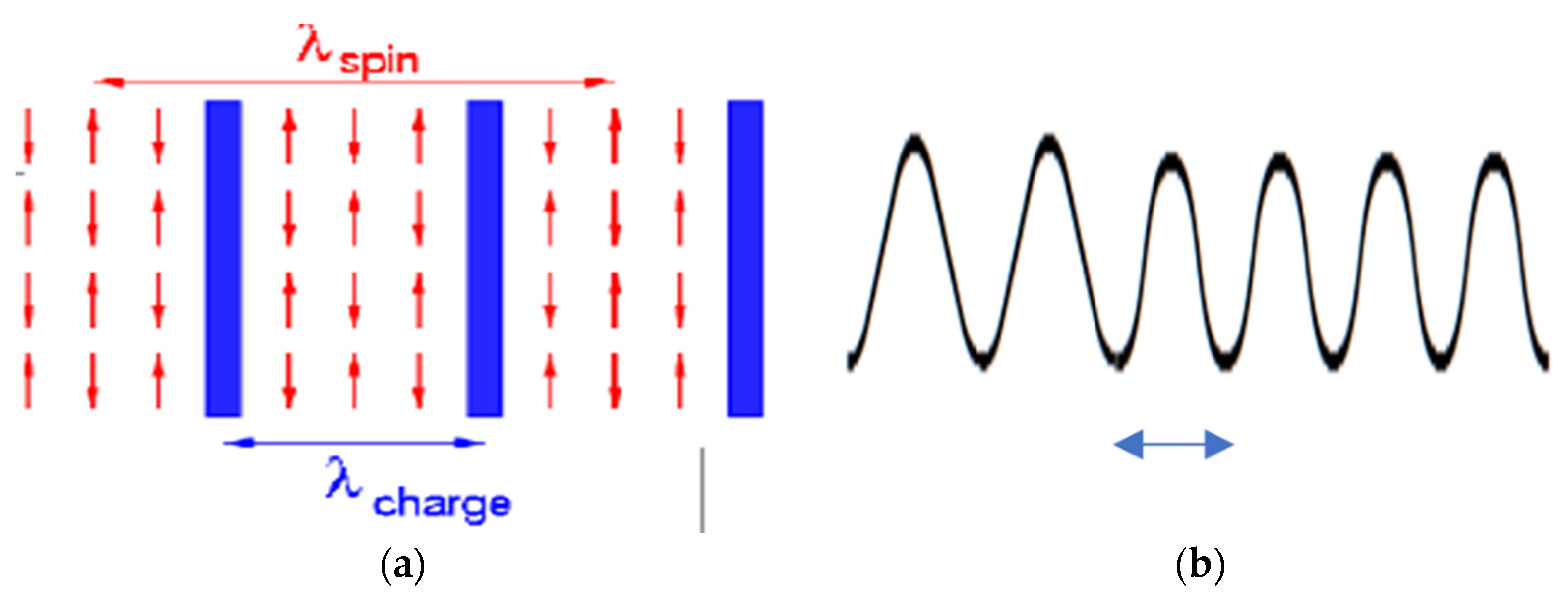
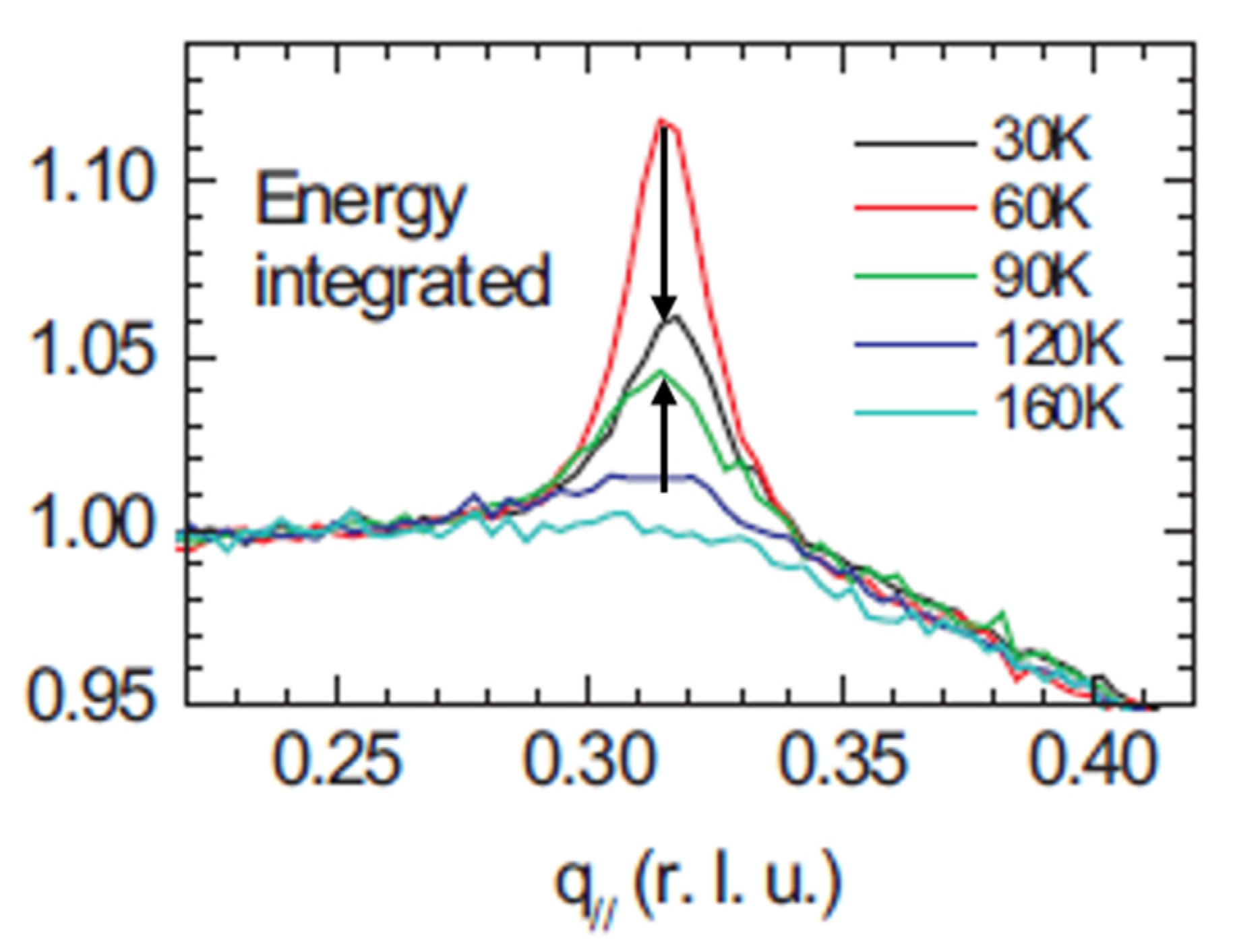

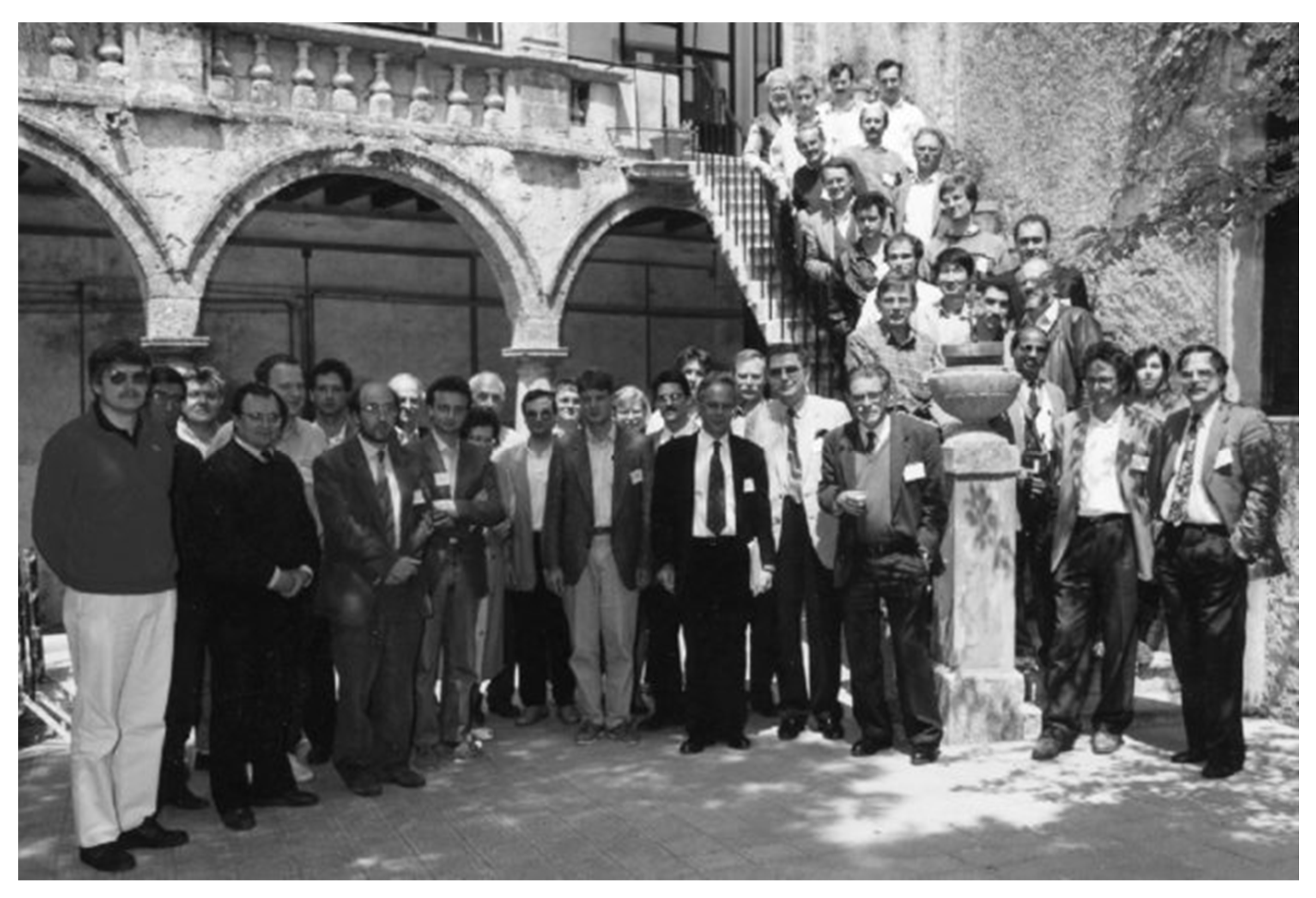

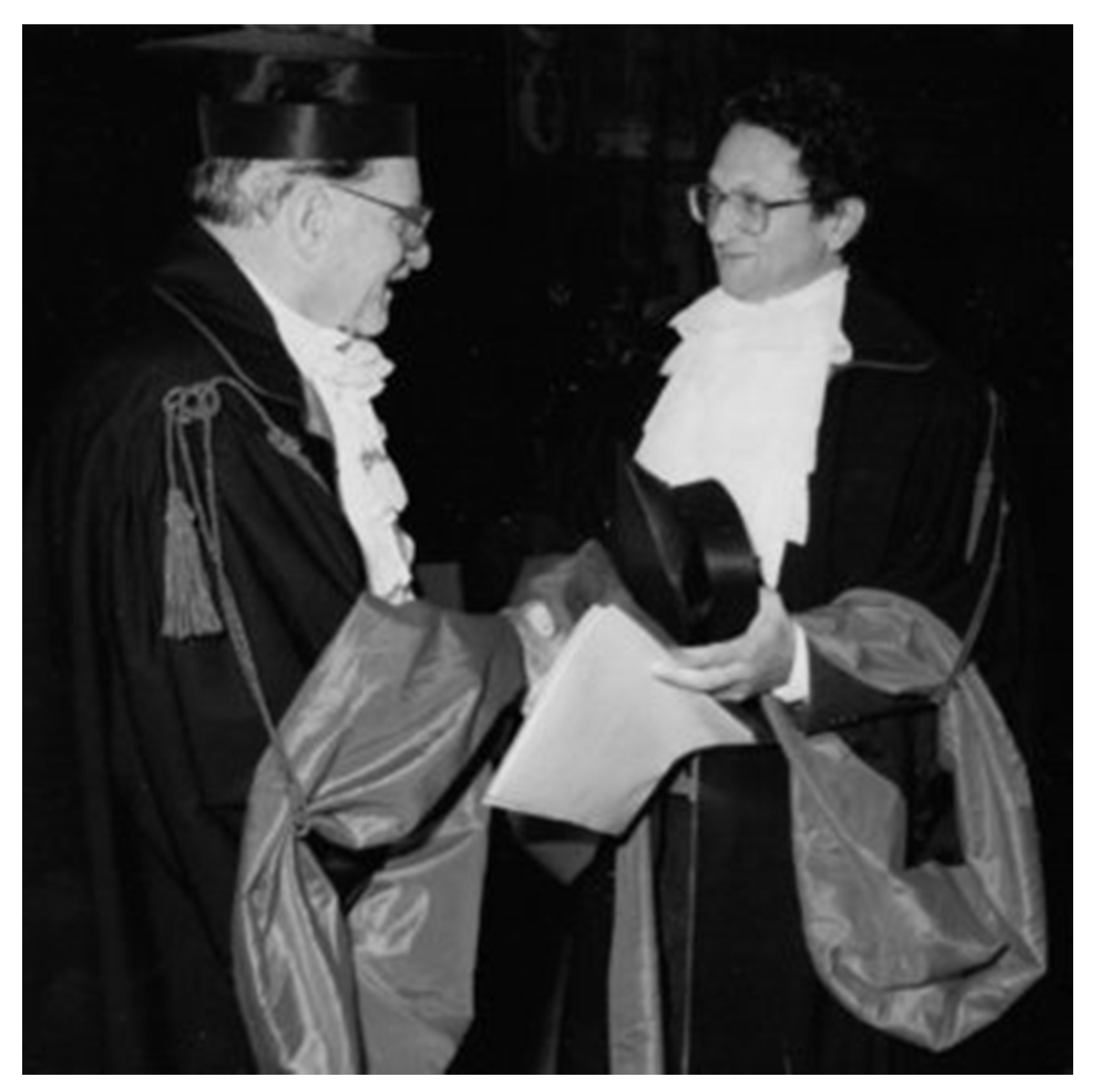

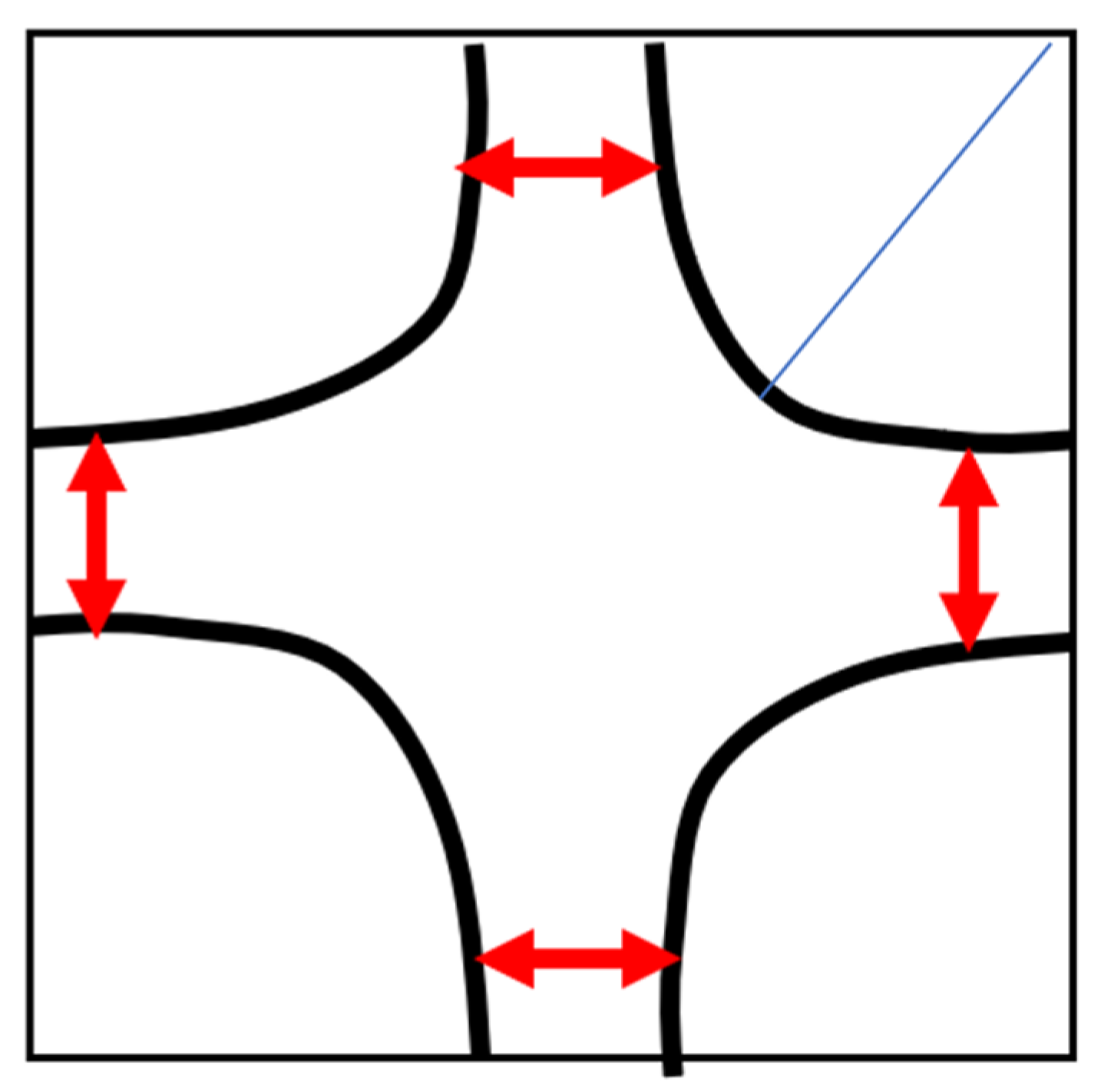

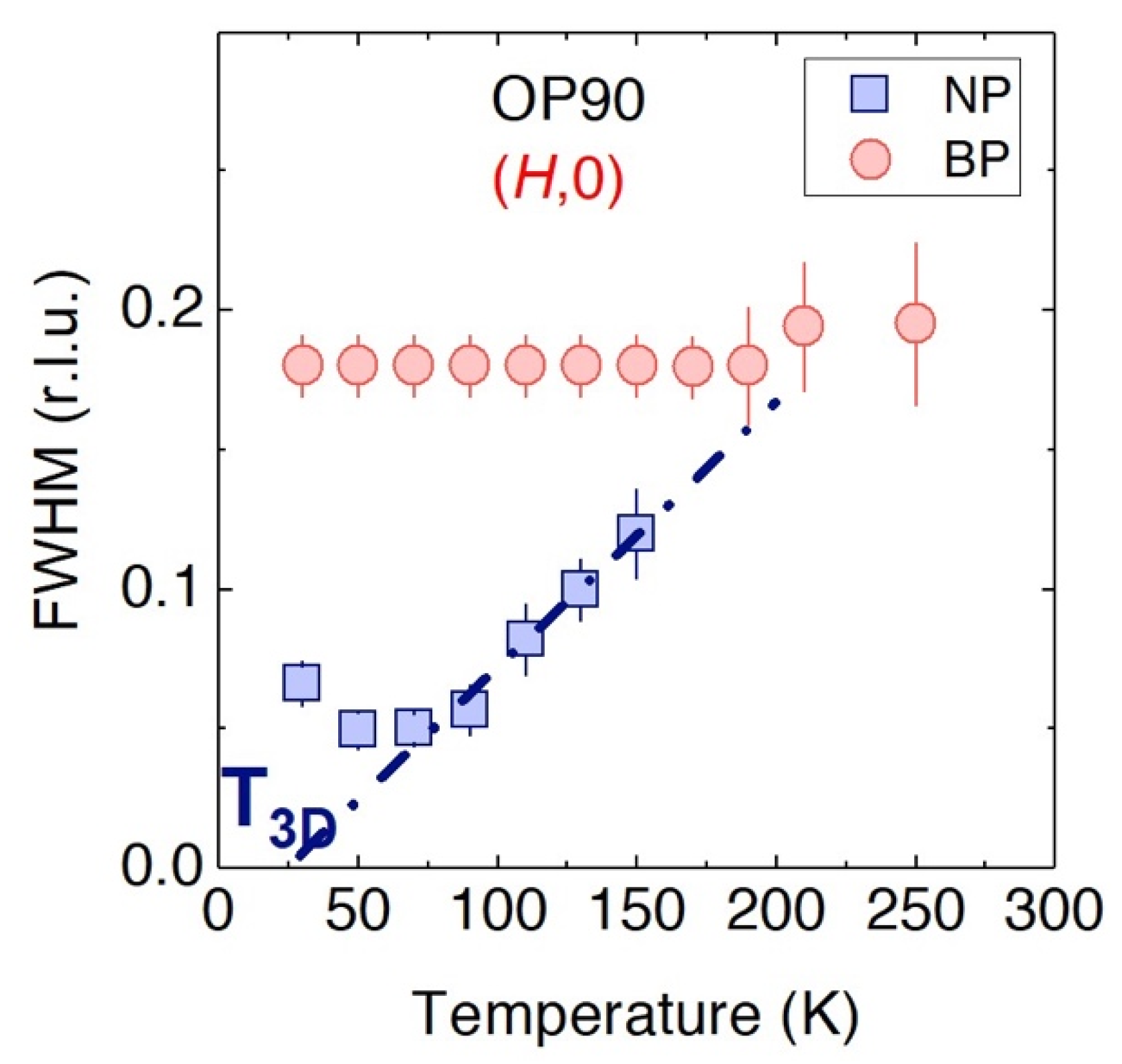
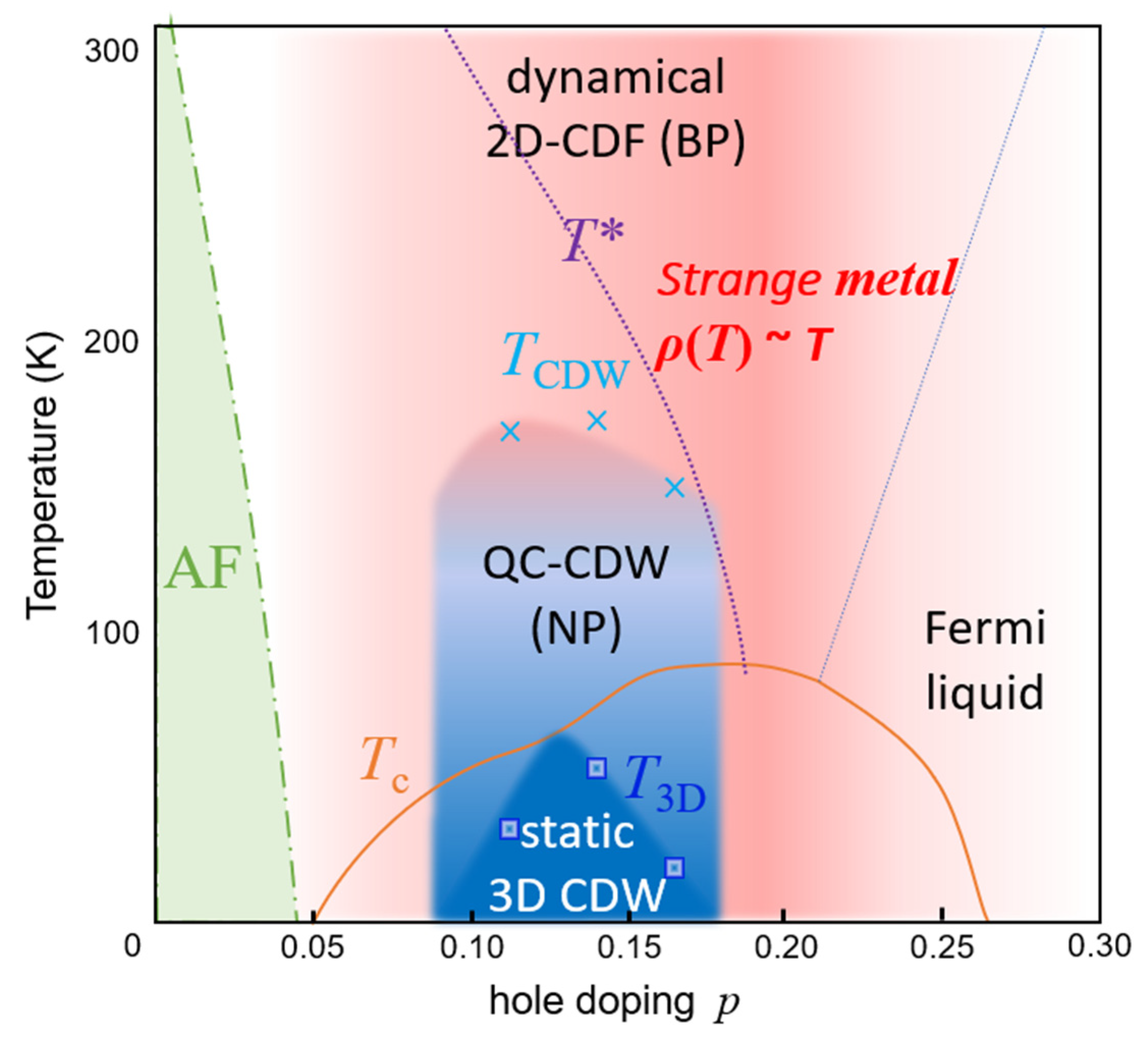
Publisher’s Note: MDPI stays neutral with regard to jurisdictional claims in published maps and institutional affiliations. |
© 2020 by the author. Licensee MDPI, Basel, Switzerland. This article is an open access article distributed under the terms and conditions of the Creative Commons Attribution (CC BY) license (http://creativecommons.org/licenses/by/4.0/).
Share and Cite
Di Castro, C. Revival of Charge Density Waves and Charge Density Fluctuations in Cuprate High-Temperature Superconductors. Condens. Matter 2020, 5, 70. https://doi.org/10.3390/condmat5040070
Di Castro C. Revival of Charge Density Waves and Charge Density Fluctuations in Cuprate High-Temperature Superconductors. Condensed Matter. 2020; 5(4):70. https://doi.org/10.3390/condmat5040070
Chicago/Turabian StyleDi Castro, Carlo. 2020. "Revival of Charge Density Waves and Charge Density Fluctuations in Cuprate High-Temperature Superconductors" Condensed Matter 5, no. 4: 70. https://doi.org/10.3390/condmat5040070
APA StyleDi Castro, C. (2020). Revival of Charge Density Waves and Charge Density Fluctuations in Cuprate High-Temperature Superconductors. Condensed Matter, 5(4), 70. https://doi.org/10.3390/condmat5040070



